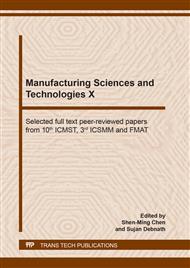p.139
p.147
p.154
p.163
p.169
p.178
p.185
p.191
p.198
Application of Neural Network in Predicting Forging Hardness
Abstract:
This study used cold forging to produce car components with the desired hardness without using postprocessing methods such as heat treatment, surface blasting, and polishing. Material diameter, mold neck diameter, and hardness of the material after annealing were used as parameters, and nine sets of experimental parameters were obtained using the Taguchi method. Under the premise of high-quality forging, this study determined the optimal hardness and the relationship between formation parameters and forging hardness. By inputting the hardness data obtained from the Taguchi L9 orthogonal array into a Matlab-implemented neural network, this study determined a hardness formula. Finally, using the inbuilt graphical user interface software of Matlab, a simple program was written that can be used to predict hardness and that could extensively reduce the costs and time associated with forging development.
Info:
Periodical:
Pages:
169-177
Citation:
Online since:
June 2020
Authors:
Keywords:
Price:
Сopyright:
© 2020 Trans Tech Publications Ltd. All Rights Reserved
Share:
Citation:


